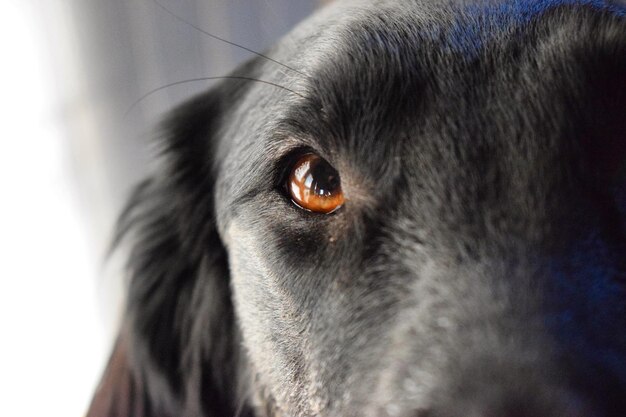Recognizing Cataracts in Dogs: What Signs Should You Look For?
Is your furry friend displaying subtle changes in their behavior or appearance? It might be time to pay closer attention. Dogs, much like humans, can develop cataracts, hindering their vision and quality of life. Understanding how to identify the signs of cataracts is crucial for ensuring prompt veterinary care, which can prevent more severe complications.
🐾 Understanding Dog Cataracts
Cataracts in dogs occur when the clear lens of the eye develops a cloudy or opaque area, affecting the passage of light to the retina. This cloudiness impairs vision and can progress to complete blindness if untreated. Dogs of any age, breed, or size can develop cataracts, though certain factors may increase the likelihood.
Common Causes of Cataracts in Dogs
- Genetics: Some breeds are genetically predisposed to developing cataracts. Breeds such as Cocker Spaniels, Poodles, and Siberian Huskies are more prone to this condition.
- Diabetes: A significant number of diabetic dogs develop cataracts. Monitoring and managing a dog’s diabetes is crucial to prevent eye-related complications.
- Aging: As dogs age, they may naturally develop cataracts. It's part of the normal aging process for many dogs.
- Injury or Trauma: Injuries to the eye can lead to cataract formation.
- Nutritional Deficiencies: Lack of certain nutrients can contribute to eye health issues, including cataracts.
🐕 Signs Your Dog May Have Cataracts
Providing the right care begins with recognizing the signs. Here’s what to look for:
Changes in Eye Appearance
Cloudiness: The most obvious sign of cataracts is a cloudy or bluish tint in the lens of the eye. This cloudiness may start small and become more noticeable over time.
Pupil Appearance: Observe if your dog's pupils appear white or grey rather than the usual dark color.
Behavioral Changes
Bumping Into Objects: If your dog is learning new navigation routes around familiar spaces or frequently bumping into furniture or walls, it could be due to impaired vision.
Reluctance to Move: Dogs with cataracts may become more hesitant to engage in physical activities, such as running or jumping, due to decreased confidence in their vision.
Clumsiness: Increased clumsiness or misjudging distances might reflect changes in their visual perception.
Cautious Walking: If your pup is walking slowly and cautiously, it might be trying to compensate for its impaired vision.
Observation Tips
- Monitor your dog's response to light. Dogs with cataracts may have difficulty adjusting to bright lights or may squint more than usual.
- Look for signs of eye discomfort or irritation, such as excessive tearing or redness.
How Veterinarians Diagnose Cataracts
If you notice signs of cataracts, a visit to the veterinarian is essential. Professionals use a variety of methods to diagnose the condition:
Eye Examination
Veterinarians perform a thorough eye examination to check for cloudiness, abnormal pupil coloration, or other signs of cataracts. They may use specialized equipment, such as an ophthalmoscope, to examine the internal structures of the eye.
Additional Tests
In some cases, veterinary ophthalmologists may recommend additional tests, such as:
- Electroretinography to assess retinal function.
- Ultrasound to view the structures in and around the eye, especially if the cataract obstructs the view.
Treatment Options for Cataracts in Dogs
Once diagnosed, the treatment plan for cataracts depends on several factors, including your dog's age and overall health.
Surgical Removal
The most effective treatment for cataract-induced vision loss in dogs is surgical removal. Here’s what you need to know:
- Procedure: A specialized veterinary surgeon removes the cloudy lens and can often replace it with an artificial one.
- Recovery: Postoperative care is critical to maximize success rates and usually involves administering eye drops and keeping your dog from rubbing its eyes.
Non-surgical Management
For dogs that are not good candidates for surgery, managing the underlying cause, such as diabetes, and close monitoring can help prevent cataract progression.
Caring for a Dog with Cataracts
Even if surgery isn't an option, dogs can still live happy lives with cataracts with the right care and adjustments.
Environmental Adjustments
- Maintain a Consistent Layout: Keep furniture and household items in the same place to help your dog navigate comfortably.
- Use Ramps or Pet Stairs: Assist your dog in reaching higher places, reducing the risk of injury.
- Safety Proof Your Home: Ensure sharp or dangerous objects are out of reach to prevent accidents.
Lifestyle Tips
- Daily Walks: Stick to familiar routes during walks to make your dog feel secure.
- Engage Other Senses: Use verbal cues and touch-based commands to guide your dog.
Nutrition and Supplements
- Ensure your dog receives a balanced diet rich in nutrients essential for eye health.
- Discuss with your vet about omega-3 fatty acids or antioxidant supplements that might support eye health.
📋 Summary: Key Takeaways for Dog Owners
- 🟢 Recognize Changes: Look for cloudiness in the eyes and changes in behavior like increased clumsiness or reluctance to move.
- 🟢 Visit the Vet: Early diagnosis by a veterinarian is crucial for determining the best course of action.
- 🟢 Consider Surgery: Surgical options are highly successful but require proper follow-up care.
- 🟢 Make Adjustments: Adjust your home environment and daily routines to accommodate your dog’s vision changes.
- 🟢 Support with Diet: Maintain a nutrient-rich diet to support overall health.
Through attentive care and timely intervention, you can help ensure your dog maintains a comfortable and happy life, even with cataracts. Regular visits to the veterinarian and a mindful approach to their changing needs will ensure your furry friend continues to thrive. 🐶❤️
